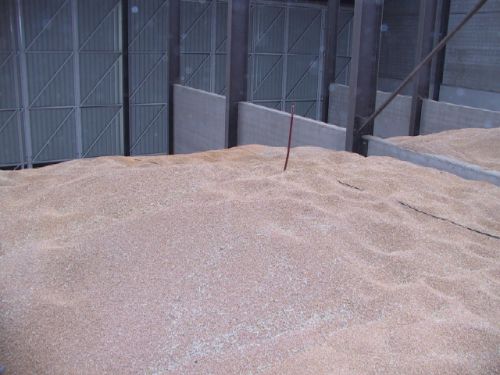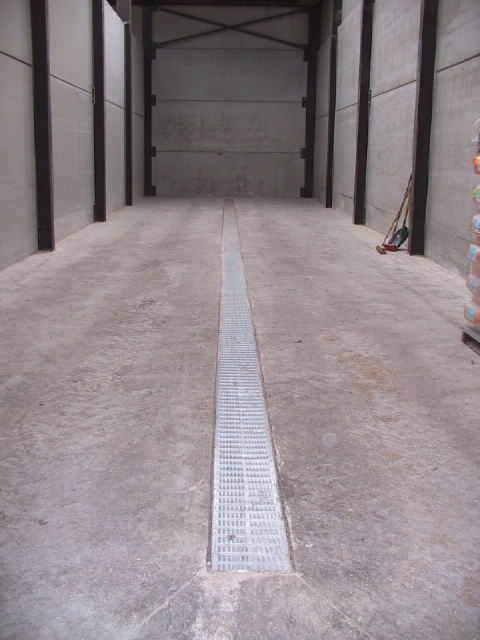Context
Storage of cereals should be done in the optimal conditions of temperature and humidity in order to keep the grains quality. Temperature below 5°C and moisture content under 15-16 % stop the germination and the development of pests and diseases.Therefore the cooling ventilation is certainly one of the main aspects of the cereals storage. In Belgium, the cooling process is done by ventilating the cereals with outside fresh air during the night or frosty days. The cooling process is realized in three steps of 5-8°C each. Just after the harvest (July-August), the first step decreases the temperature from ± 30°C to 20°C which reduces the grains respiration and avoids natural heating. In autumn (September – November), the second step aims at decreasing the temperature up to 10-12°C which blocks pests and moulds development. The third step staggered over November-January decreases the temperature under 5°C which allows to preserve the grains for a long period having sprout-inhibition and pesticides effects.
The cooling process has an energetic cost that needs to be decrease by a good management of the process and by using adapted equipments.
In this context, Walagri in collaboration with the CRA-W decided to assess its storage method regarding the energy consumption. Walagri is one of the main cereal stocking in Belgium and has stored, in 2008/2009, 482 000 tons of cereals in 68 different sites. In 2008, the electricity used for ventilation has represented 65% of the total electricity expenditure.
Objectives
The general objective of this study was to compare different types of storage facilities regarding their energy consumption (electricity) for the cooling process.Specifically, we compared the two main storage facilities found at Walagri: ACMB facility (rectangular and vertical cells, individual capacity from 400 to 1000 tons) and silo box (rectangular and horizontal cells, individual capacity from 400 to 1500 tons) in order to determine the most efficient one in term of energetic consumption.
Then we determined the most efficient fan (axial or centrifugal) and the optimal number of storage cells to be ventilated by the same fan.
Results obtained
First the evolution of the different temperatures (temperatures of the grain at the top and the bottom of the silo, temperatures of the outside and ventilation air) during the trials has been expressed graphically as given in the figure 1. Moreover, the ventilation periods were also transferred in this graph showing the effect of the ventilation on the temperature of grains. Figure 1 shows a perfect cooling process. Each ventilation period decreases effectively the grains temperature step by step.The storekeeper uses cleverly the cold period (night) presenting a sufficient thermal gradient (>8°C) to ventilate the silo and avoids the temperature peaks (day).
Cooling processes observed during the trials were not always so efficient. Bad-managed, the ventilation can lead to a re-warming of the grain which translates into energy wastes.
Based on the temperature curves, we determined the efficient ventilation hours (=ventilation hours having really cooled the grain) and compared them to the total ventilation time. On average, the efficient hours reached 47.5% of the total ventilation time for all trials.
In order to compare the storage facilities, we used a specific parameter called the efficient consumption which is the energy consumed to decrease the temperature of one ton cereals by one degree (kWh/t °C).
The comparison of the average efficient consumptions for ACMB and Silo Box have show that the silo box presents a median efficient consumption of 0.113 kWh/t°C and ACMB storage of 0.152 kWh/t°C. Silo boxes seem to present a better efficiency than ACMB ones. This could be explained by the older technology of the latest. Moreover, the silo boxes are more flexible for the storage of different products.
Axial fan are clearly more efficient and economical than the centrifugal fan. Axial fans present median efficient consumptions of 0.078 kWh/t°C whereas this reaches 0.180 kWh/t°C for the centrifugal fans. The fan type is clearly a determining factor of cooling process efficiency. Axial fans present a better consumption efficiency than the centrifugal ones. That can be easily explains by the fact that the centrifugal fans are generally over-sized for the storage.
To increase the number of cells (ACMB storage) ventilated by the same fan can improve a bit the cooling efficiency. Four cells ventilated simultaneously present median efficient consumptions of 0.145 kWh/t°C whereas two cells needs 0.154 kWh/t°C.
This study has show that silo boxes with axial fans have better energy efficiency. Regarding older storage facilities (ACMB), it is possible to reduce the electricity consumption per ton of grains by increasing the number of cells simultaneously ventilated.
This impact of a bad management on the efficient consumption, and so, on the electricity consumption is significant with more than 50% of the ventilation hours that do not cool the grains. Those hours of ventilation aren’t efficient and lead to over-consumption of electricity and useless expends. These low performances are mainly due to a bad management of the ventilation. These results show the interest for Walagri to use equipments for the automation of the ventilation.
Following this study, other trials were done during the season 2009/2010 in order to compare the electricity consumptions for the cereal storage in 3 different management systems: hand control, semi-automatic and full automatic.
Partners
WalagriCRAW off coordinator
CRA-WFunding
- CRA-W - Walloon Agricultural Research Centre




